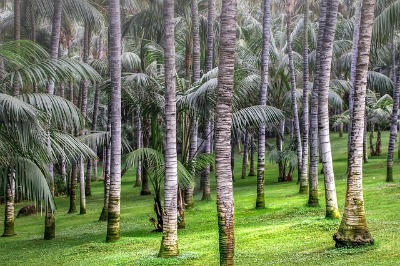Cover crops (also written in a single word, i.e., covercrops) are plants grown primarily to prevent the soil from being eroded by wind and water.
In addition, they help regulate soil temperature, suppress weed growth, reduce pests and diseases, minimize loss of water from the ground through evaporation, enhance soil fertility, add organic matter to the soil, improve soil aeration, and promote high water infiltration.
Special Uses of Cover Crops
Besides the various advantages provided above, cover crops have several important uses in which case they are also referred to by special terms.
The most common special use of these crops is as feed for livestock animals.
Other species are also suitable as groundcovers and turfgrasses in landscaping.

Pasture and Forage Crops are those grown to be taken advantage of as the source of feed to livestock primarily through pasturage, cut-and-carry, silage, or hay.
These can be either grass alone, leguminous crops, or mixed grass-legume crops.
These crops are ideal in mixed crop-livestock integrated farming systems (click to read on a separate window how livestock integration benefited mango).
Examples of grass forage crops suitable under perennial crop farms integrated with ruminant animals are carabao grass (Paspalum conjugatum) and Bermuda grass (Cynodon dactylon).
Examples of leguminous forage crops that can also be used as cover crops are centro (Centrosema pubescens), siratro (Macroptilium atropurpureum), kudzu (Pueraria phaseoloides), and pinto or creeping peanut (Arachis pintoi).
Leguminous crops, mostly vines, are commonly favored in farms grown to perennial cash crops like coconut.
Fast-growing vines can easily cover the spaces between crop plants and kill weeds, including cogon (Imperata cylindrica), by depriving them of sunlight.
The shading of the soil will prevent the germination of weed seeds.
Legumes are also good sources of feed for ruminant animals. Being high in nitrogen content, they are an excellent substitute to manure for vermicomposting.
Legumes are capable of fixing nitrogen from the air through a symbiotic association, called mutualism, with Rhizobium bacteria.
The amount of nitrogen that leguminous cover crops accumulate ranges between 40 to 200 lbs per acre (45.83 to 224.17 kg per hectare).
About 40 to 60 percent of this nitrogen will become available to the following crop if the cover crop is used as green manure according to Sullivan (2003).
A close relative of the pinto peanut, the rhizoma perennial peanut (Arachis glabrata), is popular in the US.
As of 2008, more than 26,000 acres (10,522 ha) have been planted to the ‘Florigraze’ and ‘Arbrook’ cultivars of the rhizoma peanut in Florida, Georgia, and Alabama.
These were sold mostly for hay at prices comparable to alfalfa (NRCS, 2008).
Groundcovers and turfgrasses are those low-lying plants that are primarily chosen for aesthetic enhancement in landscaping.
As such they are considered ornamental crops.
Herein author favors the planting of either carabao grass or creeping peanut or both in separate spaces.
Both are easy to propagate and are fast growers. In just a short time they can establish a complete ground cover.
Livestock animals can be raised to take advantage of forage and to serve as biological mowers.
With controlled stocking density, it is possible to transform the carabao grass into turfgrass.
With luck, the farm can be transformed into a pleasing landscape of shade-providing perennial crops carpeted with green and flowering vegetation.
The carabao grass is particularly ideal as turfgrass. With continuous grazing, it can transform into a vegetal mat.
Ultimately, the farm will have the ability to supply soil slices with carabao grass to landscapers. Such a landscape should also favor developing a farm for agri-tourism.
REFERENCES
Coconut Committee. 1983. The Philippines recommends coconut. Los Baños, Laguna: PCARRD. 89 p. (PCARRD Technical Bulletin No. 2A).
Committee on Forage and Pasture Crops. 2001. The Philippines recommends for forage and pasture crops. Los Baños, Laguna: PCARRD-DOST and Agrikulturang MakaMASA- Livestock Program- DA. 93 p. (Philippines Recommends Series No. 12-B).
Natural Resources Conservation Service (NRCS). 2008. Rhizoma perennial peanut- the perennial peanut for urban conservation in Florida. Retrieved October 3, 2010, from http://www.plant-materials.nrcs.usda.gov/pubs/flpmsfo8065.pdf.
Sullivan, P. 2003. Overview of cover crops and green manures. Retrieved October 2, 2010, from http://attra.ncat.org/attra-pub/covercrop.html.
